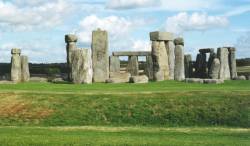Stonehenge's Construction History
Stonehenge, near the village of Amesbury on Salisbury Plain in Wiltshire, has been altered several times in its history. The various stages in its construction have been termed Stonehenge Ia, Ib, II, IIIa, IIIb, IIIc, IIId, and IV. The first building on the site took place around 3100 BC, and the last phase was completed in around 1100 BC.
However, in 1966, three totem poles (with pinewood pulp still at the bottom of them) were discovered 253 m northwest from the centre of present-day Stonehenge. They were dated back to around 8000 - 7000 BC. Many archaeologists have termed these relics Stonehenge '0'. The dating of the pulp remaining in the three pits suggests that the poles were not erected simultaneously. They are more likely to have been placed there after each other, replacing the previous one as it fell into disrepair. Three white circles now mark their positions, as the car park was built over them.
The following table (edited from Castleden, 1993) shows the main phases of Stonehenge's constuction.
| Stonehenge version | Date (approx, BC) | Developments |
|---|---|---|
| '0' | 8000 - 7000 | |
| I a | 3100 | |
| I b | 2910 | |
| II | 2150 | when just over half complete) |
| III a | 2100 | |
| [ III b ] | [ 2000 ] | [ Bluestones used to build Bluestonehenge (location unknown) ] |
| III c | 1800 | |
| III d | 1500 | |
| IV | 1100 | |
| AD 61 |
